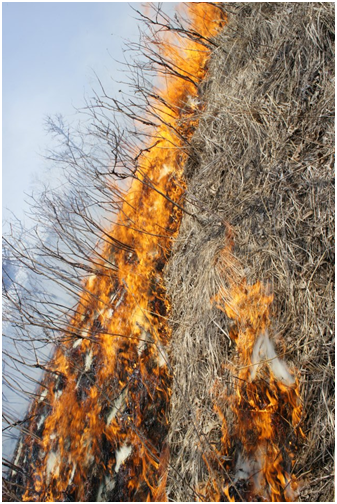Why we do prescribed burns
By: Tiffany Howard

The past couple of weeks have been good burning weather so we have been doing a lot of prescribed burns in the local state parks. We have burned two bluff prairies in Great River State Park in Nodine, MN. This slanted picture of fire running up hill is the actual gradient of the goat prairie, if you stood straight up you would fall over. Walking down the bottom of this prairie was quite the adventure!
A lot of people are not familiar with how prescribed burning works or why we do it, so I will give you a quick rundown. Prescribed burning is a useful tool in natural resource management. It can be used to clear areas, to burn native grasses and make them come back more luscious the next year, to kill invasive species such as buckthorn and non-native honeysuckle or to remove fuels such as leaf litter to decrease the chances of a wildfire. Learn more about prescribed burns.
Prescribed burns kind of work like this: the area, whether private or public is scoped out by our burn boss. The weather is then checked for humidity, rain chances, wind direction, etc. Our boss then fills out paperwork, files burn permits, and contacts the local authorities to let them know we are planning a burn. Either the day before or the morning of we set out to build a fire line. This line is wide enough that the fire cannot cross (we hope!). We build it by using rakes, shovels, leaf blowers, brush saws, any hand tool that will really help us remove grass, trees and leaf litter making a four to five foot long path.
When we begin our burns, we communicate who is doing what, then we take drip torches filled in a 1:3 ratio of unleaded to diesel fuel, which are then lit on fire and carried down the line. If we are burning a bluff prairie, we usually burn about 30 feet of the top of the prairie so that when we send flames from the bottom (fire loves running up hill) we have a safety zone so the fire won’t jump our fire line.
We also carry bladder bags, which are about 45 pounds each on our backs. They have a nozzle and we pump to spray water on the smoldering piles when we are done. We let the fire do the work, and then put out any logs or sticks on fire before we leave. It is quite a lot of fun, but the hiking up and down such a steep incline can be hard on the knees! Needless to say, we are having a blast down here in Southeastern Minnesota!
A video of a fire whirl for your viewing pleasure!